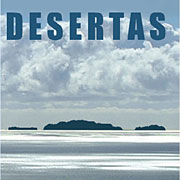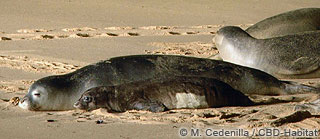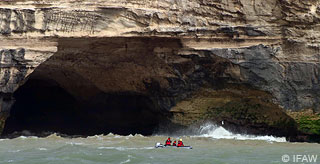

 |
||
 |
||
Vol. 11 (1): June 2008 |
||
Croatia / Greece I / Greece II / Madeira / Mauritania & Western Sahara / Turkey
Madeira
|
 |
|
|
Madeira schools programme. |
Monk seals are currently much closer to humans since their recent return to Madeira Island. Considering this fact, public awareness activities have been augmented, mainly within crèches and primary schools. Between 2006-2007, 494 children and 23 schools participated in the monk seal workshop created specifically for young children; 1,014 students involving 15 primary and secondary schools participated in talks about the species. A touring monk seal exhibition travelled all around Madeira, and has proven the most requested exhibition of its kind from the PNM Service. – Rosa Pires, Parque Natural da Madeira.
During the last three years it has become evident that many members of the public do not report their monk seal sightings to the PNM Service. The reason appears to be that such sightings around Madeira are no longer considered something new or exceptional.
However, without this information it is almost impossible to monitor the species around the island. In an effort to remedy the problem, the PNMS launched a visit programme to beach resorts, marinas, and scuba diving centers in the southeast of Madeira. In total, 21 locations are visited every month, in Caniçal, Santa Cruz and Funchal, with members of the public being made aware of the importance of their monk seal sightings records by PNMS staff. – Rosa Pires, Parque Natural da Madeira.
 |
|
|
|
The Desertas Islands Nature Reserve was created with the aim of protecting, both rationally and effectively, a natural heritage with a high ecological value. A glance at the Desertas islands awakens in our imagination a sense of adventure and mystery. The mystery of nature… This is how a new educational CD on the Desertas invites us to discover some of the mysteries of those islands.
Launched in March, the CD is in Portuguese and English and introduces the Desertas Islands Nature Reserve through written information, pictures, and also games for younger people. The monk seal is portrayed as the figurehead species of the islands. – Rosa Pires, Parque Natural da Madeira.
Also on the audiovisual-educational front, an animated film about monk seals at the Desertas Islands premiered on YouTube in December.
Though some factual details are open to question, the animations are exceptional, and the conservation message undisputed. The film, produced by Madeira Magic/Arquimedes is in Portuguese and English, and in two parts. The films have attracted a 4 and 5 star user rating respectively.
The presence of scars as a result of interactions between animals and interactions with the environment can be used to individually photo-identify the members of the Cabo Blanco population. Also, in the case of adult males, the unique design of their ventral patch can also be used to individually identify them.

From the catalogue.
As a result of 4 photo-identification sessions during the period 2003-2007, and the continuous monitoring performed at the colony breeding caves through the video surveillance cameras, 17,488 pictures and 1,646 images captured from the video cameras of the members of the colony were obtained in order to identify individuals and complete the existing catalogue.
As a result, 59 adult males, 59 reproductive females, 5 sub-adult males and 15 adults and sub-adults of undetermined sex were individually identified. In total, 138 individuals from the adult and sub-adult section of the population have been identified. So far, no juveniles have been included in the catalogue due to the difficulty of individually identifying them because of the scarcity of scars and natural distinguishing marks. – Miguel A. Cedenilla, Mercedes Muñoz, Moulaye Haye and Pablo Fernández de Larrinoa, Fundación CBD-Habitat.
As reported previously in The Monachus Guardian [Notable increase of newborn pups at Cabo Blanco, TMG November 2006], an average 26.5 pups per year were born during the period 2000-2005 at the Cabo Blanco colony. In 2006, pup production increased significantly to 48 pups, and this 2007 breeding season, productivity has remained at this high level, with 46 pups being detected in the breeding caves colony. This notable increase in pup production is due to the incorporation of new females into the reproductive section of the population.
 |
|
|
Mother and pup at Cabo Blanco. |
Together with the increase in pup production, the pup mortality rate has also remained lower than in previous years, with 74% of the pups born having survived to the first moult. This is due to the widening of the breeding season to the summer months, causing many pups to be born during months with good weather conditions.
Both facts, a higher number of pups being born, and a higher number of pups that survive to the first moult, undoubtedly contribute to a higher recovery of the Cabo Blanco population. – Miguel A. Cedenilla, Moulaye Haye, Hamdi M’Barek and Pablo Fernández de Larrinoa. Fundación CBD-Habitat.
The Mediterranean monk seal is among the ten most endangered mammals in the world. Its largest population, and the only one that maintains a colony structure, is on the Atlantic coast of the Cabo Blanco peninsula (Morocco/Mauritania). However, despite years of study and conservation efforts made mainly by the team of the CBD-Habitat Foundation, the coastline to the north of the colony (between Cabo Corbeiro and Castillete de la Mesa) has remained practically unexplored, mostly due to its inaccessibility problems. Previous expeditions to this area performed in the last twenty years (Soriguer 1976; Marchessaux et al. 1988; El Amrani et al. 1992) showed the possible presence of monk seal individuals along this coastline, although their exact locations and the population size couldn’t be determined.
 |
|
|
Exploring the unexplored coast. |
In May (2005), within the framework of the International Monk Seal Recovery Plan in the Eastern Atlantic, developed by Morocco, Mauritania, Portugal and Spain (Convention on Migratory Species, UNEP/CMS), most parts of the coast were surveyed on board the R/V “Song of the Whale” of the International Fund for Animal Welfare (IFAW). The objective was to locate monk seal individuals and gather information about the conservation status and threats of the species in the area.
The whole coastline between Cape Corveiro and Castillete de La Mesa was surveyed. Although no monk seals were observed during the survey, questionnaires conducted with local fishermen and Moroccan military personnel, confirmed several sightings in recent years, implying that the area is used by seals. Human threats were also identified, most of them related to illegal fishing and collection of crustaceans, as well as an increase of human disturbance, which leads us to include some preliminary recommendations in the present document.
The full report can be downloaded from the Monk Seal Library via the citation link below. – Pablo Fernández de Larrinoa, Fundación CBD-Habitat.
Fernández de Larrinoa, P., M. Idrissi, T. Lewis, A. El Mokhtar, M. Cedenilla and L.M.Gonzalez. 2007. Status of the Mediterranean monk seal (Monachus monachus) on the coastline between Cape Corveiro and Castillete de la Mesa (Morocco). Fundación CBD-Habitat, INRH/ANI/IFAW: 1-17. [PDF ![]() 534KB]
534KB]
Mediterranean News continues with Turkey...
Copyright © 2008 The Monachus Guardian. All Rights Reserved |